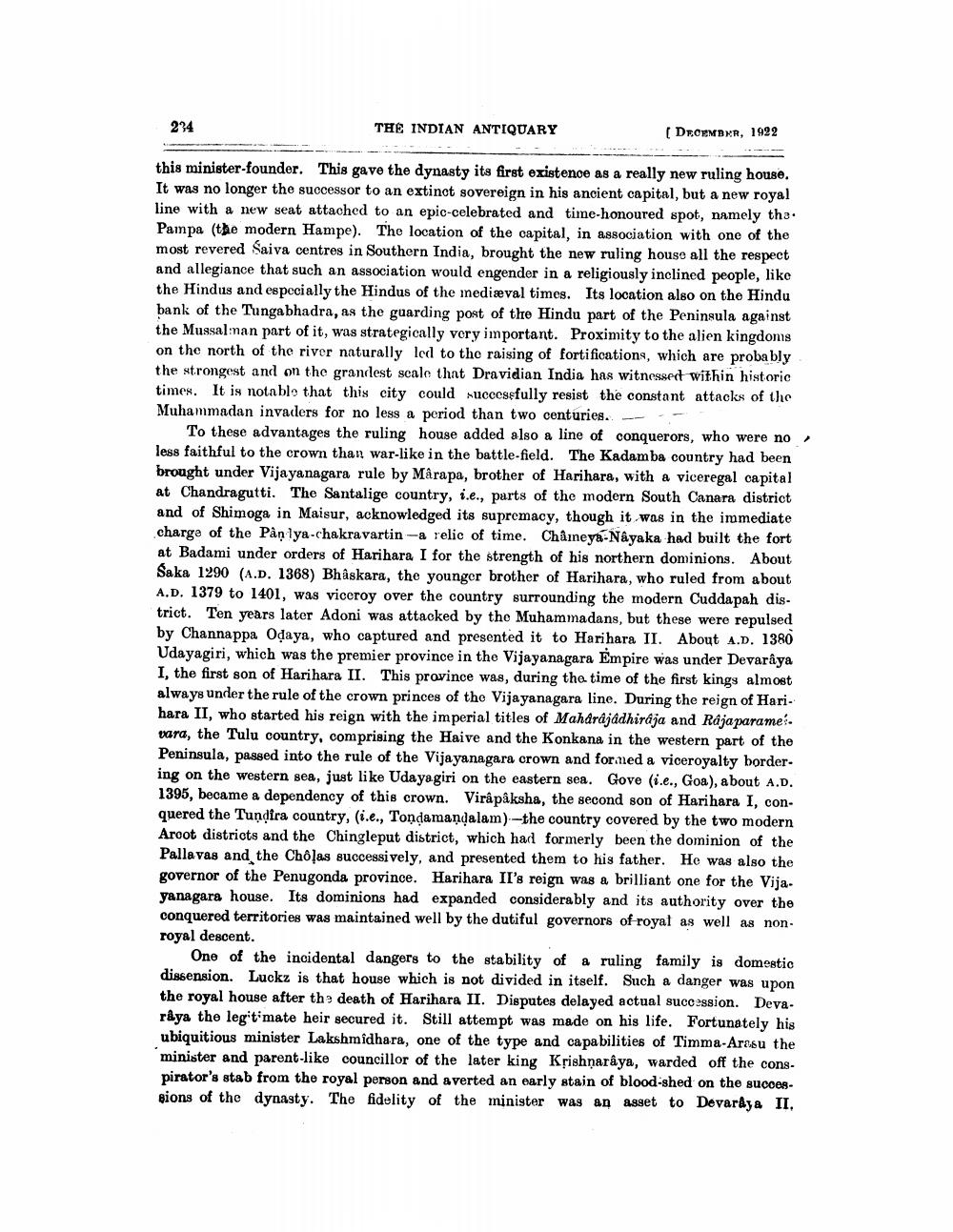________________
234
THE INDIAN ANTIQUARY
[ DECEMBER, 1922
this minister-founder. This gave the dynasty its first existence as a really new ruling house. It was no longer the successor to an extinct sovereign in his ancient capital, but a new royal line with a new seat attached to an epic-celebrated and time-honoured spot, namely tha. Pampa (the modern Hampe). The location of the capital, in association with one of the most revered Saiva centres in Southern India, brought the new ruling house all the respect and allegiance that such an association would engender in a religiously inclined people, like the Hindus and especially the Hindus of the inediæval times. Its location also on the Hindu bank of the Tungabhadra, as the guarding post of the Hindu part of the Peninsula against the Mussalinan part of it, was strategically very important. Proximity to the alien kingdoms on the north of the river naturally led to the raising of fortifications, which are probably the strongest and on the grandest scale that Dravidian India has witnessed within historic times. It is notable that this city could succesfully resist the constant attacks of the Muhammadan invaders for no less a period than two centuries. -- -
To these advantages the ruling house added also a line of conquerors, who were no less faithful to the crown than war-like in the battle-field. The Kadamba country had been brought under Vijayanagara rule by Mârapa, brother of Harihara, with a viceregal capital at Chandragutti. The Santalige country, i.e., parts of the modern South Canara district and of Shimoga in Maisur, acknowledged its supremacy, though it was in the immediate charge of the Pånlya-chakravartin-a relic of time. Chåmeya-Nayaka had built the fort at Badami under orders of Harihara I for the strength of his northern dominions. About Saka 1290 (A.D. 1368) Bhaskara, the younger brother of Harihara, who ruled from about A.D. 1379 to 1401, was viceroy over the country surrounding the modern Cuddapah district. Ten years later Adoni was attacked by the Muhammadans, but these were repulsed by Channappa Odaya, who captured and presented it to Harihara II. About A.D. 1380 Udayagiri, which was the premier province in the Vijayanagara Empire was under Devaraya I, the first son of Harihara II. This province was, during the time of the first kings almost always under the rule of the crown princes of the Vijayanagara line. During the reign of Harihara II, who started his reign with the imperial titles of Maharajadhiraja and Råja parame. vara, the Tulu country, comprising the Haive and the Konkana in the western part of the Peninsula, passed into the rule of the Vijayanagara crown and formed a viceroyalty bordering on the western sea, just like Udayagiri on the eastern sea. Gove (i.e., Goa), about A.D. 1395, became a dependency of this crown. Virâpâksha, the second son of Harihara I, conquered the Tundira country, (i.e., Tondamandalam)--the country covered by the two modern Aroot districts and the Chingleput district, which had formerly been the dominion of the Palla vas and the Chôļas successively, and presented them to his father. He was also the governor of the Penugonda province. Harihara II's reign was a brilliant one for the Vijayanagara house. Its dominions had expanded considerably and its authority over the conquered territories was maintained well by the dutiful governors of royal as well as nonroyal descent.
One of the incidental dangers to the stability of a ruling family is domestic dissension. Luckz is that house which is not divided in itself. Such a danger was upon the royal house after the death of Harihara II. Disputes delayed actual succession. Deva. rêya the legitimate heir secured it. Still attempt was made on his life. Fortunately his ubiquitious minister Lakshmidhara, one of the type and capabilities of Timma-Arasu the minister and parent-like councillor of the later king Krishnaraya, warded off the conspirator's stab from the royal person and averted an early stain of blood-shed on the successions of the dynasty. The fidelity of the minister was an asset to Devaraya II,




